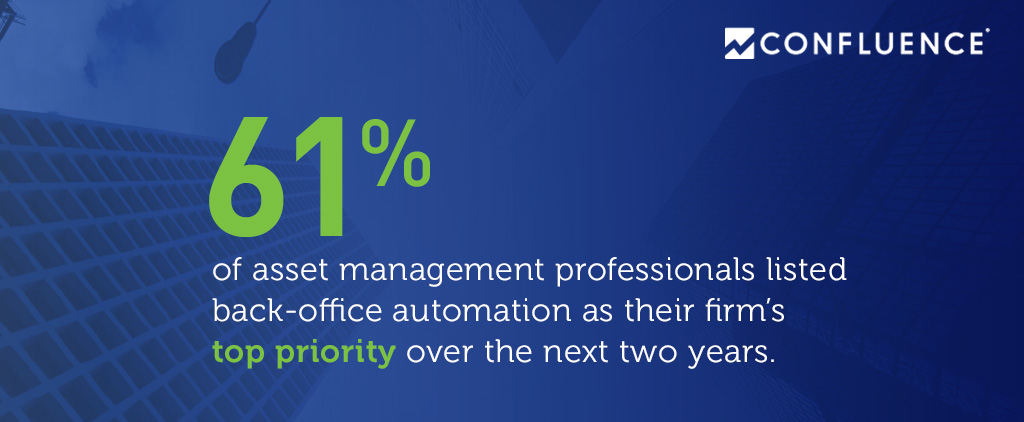At the start of each year, our team at Confluence reflects on the state of the asset management back office and predicts issues and trends that we see emerging over the coming months.
For 2016, we predicted that the asset management industry would see streamlining and optimizing their data management processes as a way to reduce risk, manage costs and create new business opportunities. We also predicted chronic regulatory fatigue would continue as the asset management industry prepared for the next round of mandates.
Those predictions appear to be becoming reality – along with a persistent desire to automate. Or so say the results of our recent asset management industry trends survey. It revealed that asset managers are prioritizing the need to improve process automation and manage regulatory reporting. And data centralization was listed as a top goal for the next two years. Regarding the latter, I’d argue that success in achieving improved process automation and managing regulatory reporting is predicated upon improved processes for data centricity and governance.

In other words, it’s time for data to work for asset managers, not the other way around.
According to the findings of our 2016 Asset Management Industry Trends survey, the majority of asset management industry professionals (61%) cited automating back-office processes as an important goal over the next two years, while managing increased regulatory reporting requirements simultaneously (47%) and centralizing fund data (44%) were the second- and third-most cited goals in this year’s survey.
Back-office automation has remained the top priority in each of the four industry surveys that Confluence has conducted since 2008. This is as much of a surprise as it isn’t one. Looking at the ongoing efforts to replace manual data management processes in the back office, it makes perfect sense that this is cited as a top priority for asset managers. However, the fact that eight years down the road this issue is still a top problem is surprising.
The survey showed us that nearly all respondents are concerned about manual processes and spreadsheets affecting the ability to control errors (91%) and the ability to control costs (81%). Yet, respondents reported that manual processes persist across the back office. For example, we recently spoke with an asset manager who uses spreadsheets to collect, track and calculate data for their Form CPO-PQR filing. These processes are just no longer feasible from a cost or risk standpoint.
We know there has been quite a lot of progress in terms of automation, but the truth is that manual processes persist here and there, with nearly three-quarters (74%) of respondents this year saying their firm still depends on multiple, disparate back-office systems. Recently, we worked with a large, global third-party administrator who uses our financial reporting solutions to automate their U.S. and retail funds. They wanted to expand their automation to hedge funds and their Australian business, and simply increasing the use of a system that had already been put in place created a significant advantage. They were able to achieve greater efficiency by consolidating their technology—something they would not have been able to do if they had to purchase different systems for each asset class and region.
But even if fragmented technology across the back office continues to be persistent, this year’s survey also revealed that the industry is increasingly focused on centralizing fund data.
For 71 percent of respondents, it is important to consolidate fund data into a common database, which represents an increase of 50 percent from 2008 when we first asked the question. Over two-thirds (69%) of respondents this year said their firm had begun to centralize fund data into one database, up from 50 percent in 2008.
An asset manager recently told us that, on the mutual fund side of the house, the number of source files required for their financial reporting is about six. With the recent SEC Modernization Rule finalized, Form N-PORT is going to require much more work; they expect the number of data files their team will need to process will jump to 20, making the need to consolidate data even more urgent.
Inefficiency is what costs firms the most. It introduces the risk of error and makes process automation more challenging.
As we move forward, we see that regulatory reporting is a driver for this trend toward data centralization. By leveraging one master set of regulatory data for reporting across an entire enterprise, asset managers can develop new reporting capabilities quickly and efficiently, enabling them to support multiple regulatory filings globally and meet the demands of new regulations. It also enables them to minimize reporting errors, and improve data accuracy and consistency.
I feel strongly that there will be clear winners and losers relating to a firm’s ability to embrace data. Despite the efforts already made, it is imperative that firms now begin to take more significant steps in realizing their goal of centralizing data. Until then, gaining real efficiencies in process automation and regulatory reporting just don’t seem possible.